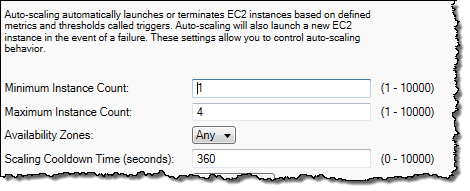Configuring Amazon EC2 Auto Scaling using the AWS toolkit for Visual Studio
Amazon EC2 Auto Scaling is an Amazon web service that is designed to automatically launch or terminate Amazon EC2 instances based on user-defined triggers. You can set up Amazon EC2 Auto Scaling groups and associate triggers with these groups to automatically scale computing resources based on metrics such as bandwidth usage or CPU utilization. Amazon EC2 Auto Scaling works with Amazon CloudWatch to retrieve metrics for the server instances running your application.
Amazon EC2 Auto Scaling lets you take a group of Amazon EC2 instances and set various parameters to have this group automatically increase or decrease in number. Amazon EC2 Auto Scaling can add or remove Amazon EC2 instances from that group to help you seamlessly deal with traffic changes to your application.
Amazon EC2 Auto Scaling also monitors the health of each Amazon EC2 instance that it launches. If any instance terminates unexpectedly, Amazon EC2 Auto Scaling detects the termination and launches a replacement instance. This capability enables you to maintain a fixed, desired number of Amazon EC2 instances automatically.
Elastic Beanstalk provisions Amazon EC2 Auto Scaling for your application. You can edit the Elastic Beanstalk environment's Amazon EC2 instance configuration with the Amazon EC2 Auto Scaling tab inside your application environment tab in the AWS Toolkit for Visual Studio.

The following section discusses how to configure Amazon EC2 Auto Scaling parameters for your application.
Launch the configuration
You can edit the launch configuration to control how your Elastic Beanstalk application provisions Amazon EC2 Auto Scaling resources.
The Minimum Instance Count and Maximum Instance Count boxes let you specify the minimum and maximum size of the Amazon EC2 Auto Scaling group that your Elastic Beanstalk application uses.

Note
To maintain a fixed number of Amazon EC2 instances, set Minimum Instance Count and Maximum Instance Count to the same value.
The Availability Zones box lets you specify the number of Availability Zones you want your Amazon EC2 instances to be in. It is important to set this number if you want to build fault-tolerant applications. If one Availability Zone goes down, your instances will still run in your other Availability Zones.
Note
Currently, it is not possible to specify which Availability Zone your instance will be in.
Triggers
A trigger is an Amazon EC2 Auto Scaling mechanism that you set to tell the system when you want to increase (scale out) or decrease (scale in) the number of instances. You can configure triggers to fire on any metric published to Amazon CloudWatch (for example, CPU utilization) and determine if the conditions you specified have been met. When the upper or lower thresholds of the conditions you have specified for the metric have been breached for the specified period of time, the trigger launches a long-running process called a Scaling Activity.
You can define a scaling trigger for your Elastic Beanstalk application using AWS Toolkit for Visual Studio.

Amazon EC2 Auto Scaling triggers work by monitoring a specific Amazon CloudWatch metric of a particular instance. Metrics include CPU utilization, network traffic, and disk activity. Use the Trigger Measurement setting to select a metric for your trigger.
The following list describes the trigger parameters you can configure using the AWS Management Console.
-
You can specify which statistic the trigger should use. You can select Minimum, Maximum, Sum, or Average for Trigger Statistic.
-
For Unit of Measurement, specify the unit for the trigger measurement.
-
The value in the Measurement Period box specifies how frequently Amazon CloudWatch measures the metrics for your trigger. The Breach Duration is the amount of time a metric can go beyond its defined limit (as specified for the Upper Threshold and Lower Threshold) before the trigger fires.
-
For Upper Breach Scale Increment and Lower Breach Scale Increment, specify how many Amazon EC2 instances to add or remove when performing a scaling activity.
For more information on Amazon EC2 Auto Scaling, see the Amazon EC2 Auto Scaling section on Amazon Elastic Compute Cloud
Documentation